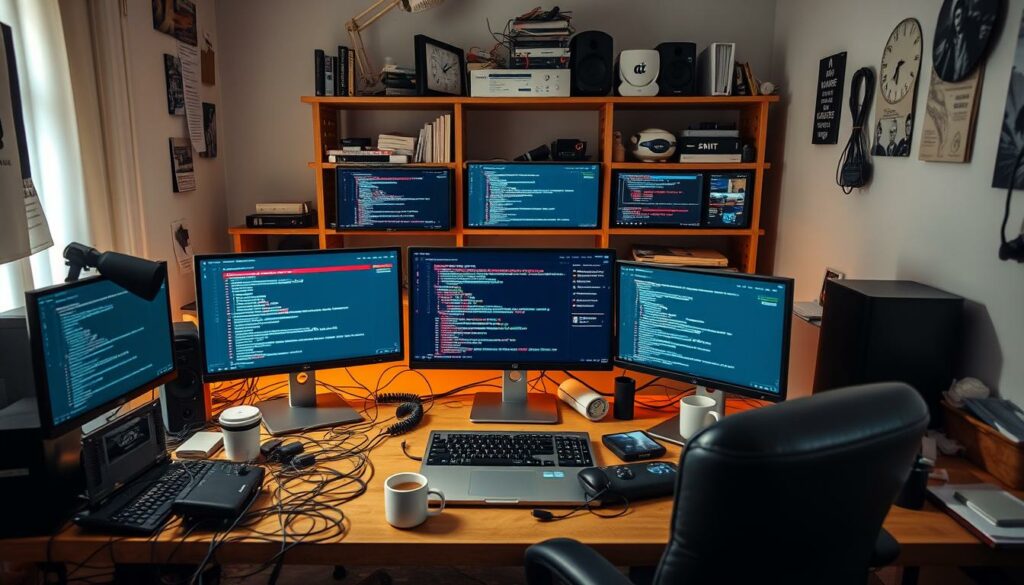Did you know that by 2023, nearly 30% of the U.S. workforce works remotely at least part-time? This shows a big change in how we work and the need for IT to adapt. Remote work has changed our daily lives, affecting how companies work, their efficiency, and how they communicate.
More people are choosing to work from home, so companies have had to change their IT systems. They’re updating their tech and finding new ways for teams to work together. This change is making us rethink what it means to be productive in today’s work world.
Key Takeaways
- The workforce is embracing remote work, with 30% engaged part-time as of 2023.
- IT infrastructure is crucial for supporting the transition to a distributed workforce.
- Businesses must rethink collaboration strategies to maintain operational efficiency.
- This shift emphasizes the importance of updating technologies for seamless communication.
- Remote work is redefining productivity standards across industries.
The Evolution of Remote Work
Work has changed a lot over the years, especially with Remote Work becoming more popular. It started with people working from home in the late 20th century. This move away from the office was made possible by early technology.
As technology got better, so did Remote Work. Fast internet and mobile devices made it easier to work with others and do tasks from anywhere. This change made people work better and changed who was working.
Now, companies offer more flexible work options because of this. The world also made Remote Work more popular. The COVID-19 pandemic made Remote Work a must for many companies. It showed how important good IT systems are for working from anywhere.
Tracking tools have become a big part of Remote Work too. These tools help make sure people stay productive even when they’re not in an office. They also help with flexible work hours without losing efficiency.
In short, Remote Work has grown because of new technology, changes in the workforce, and global events. As IT keeps evolving, companies need to keep up to make the most of a remote workforce.
The Impact of Remote Work on IT Infrastructure
Remote work has changed the IT world a lot. Now, companies are working on their networks to make sure remote workers can connect safely and efficiently. Old systems don’t work well anymore because everyone needs to access company resources reliably from anywhere.
Cloud computing has become more important because of this. Companies are moving from old systems to cloud-based services. This change makes it easier for people to work together and means the IT setup needs to be able to grow and handle more work when needed.
Data storage has also changed a lot. With more people working from home, companies need better ways to manage and keep data safe. Keeping company data safe is more critical than ever since it’s accessed from different places. Stronger cybersecurity is now key to protect against threats.
Technology like AI-driven analytics is helping too. These tools help IT teams keep an eye on how systems are doing and fix problems before they get worse. This helps make sure the move to remote work goes smoothly.
| Aspect | Conventional IT Infrastructure | Remote Work Adaptation |
|---|---|---|
| Network Architecture | On-premises servers with limited access | Cloud-based systems for enhanced connectivity |
| Data Storage | Local data storage and management | Secure cloud storage with flexible access |
| Bandwidth Needs | Fixed bandwidth capabilities | Increased bandwidth to support remote work |
| Security | Basic security measures | Advanced cybersecurity protocols |
| Monitoring | Reactive monitoring systems | Proactive analytics and AI integration |
For IT to work well with remote work, it needs a clear plan and vision. Using cloud tech and focusing on security is key. This helps make remote work work smoothly and keeps teams working together well.
Remote Work IT: Tools and Technologies for a Distributed Workforce
In today’s world, having the right tools and technologies is key for Remote Work IT and a successful Distributed Workforce. Tools like Slack, Microsoft Teams, and Zoom are crucial for keeping team members in touch. They make it easy to talk in real-time, share files, and have meetings online, which helps teams work better together.
Tools like Trello and Asana are important for managing projects. They help assign tasks, keep track of time, and make sure everyone is on the same page. These tools let you see how projects are going, set what’s most important, and keep work organized.
Using different Collaboration Tools helps create a unified work environment. They offer flexibility and better ways to manage projects. Tools for monitoring work also help spot where things might be slow or not working well. It’s important to be open about these methods to keep employees happy.
As your team gets used to working remotely, investing in good tools for working together and managing projects is smart. Here’s a look at some popular tools:
| Tool | Type | Key Features | Best For |
|---|---|---|---|
| Slack | Collaboration Tool | Real-time messaging, integration with other apps, file sharing | Flexibility and spontaneous communication |
| Microsoft Teams | Collaboration Tool | Chat, video conferencing, document collaboration | Organizations already using Microsoft Office 365 |
| Zoom | Collaboration Tool | Video conferencing, webinars, virtual backgrounds | Engaging meetings and events |
| Trello | Project Management Tool | Visual task management, checklists, due dates | Project tracking and workflow visualization |
| Asana | Project Management Tool | Task assignment, progress tracking, calendar view | Structured project planning and execution |
Choosing the right tools is key to making your Distributed Workforce work well, even when they’re not in the same place. It helps keep everyone working together smoothly.
Challenges Faced by IT During the Shift to Remote Work
As companies switch to remote work, IT faces many challenges. Keeping data safe is a top concern. Cybersecurity Ventures reports a spike in cyber attacks on remote workers. Companies must use strong security steps like firewalls and encryption to keep data safe.
Handling teams spread out over different places is tough. Tools like Controlio help track how well employees work and when they’re most active. These tools help manage projects better and improve employee skills.

Keeping everyone connected is another big challenge. Quick help for tech problems is key to avoid losing productivity. Advanced Networks offers 24/7 support to help remote workers with any tech issues.
Keeping the company culture strong and keeping employees engaged is hard in a remote setting. IT teams must find new ways to keep teams connected. Understanding the challenges of remote work helps tackle these issues better. For more tips, check out this guide online.
As work changes, focusing on flexible IT solutions is crucial. IT support needs to grow and adapt with business needs. This helps teams succeed in a digital world.
Best Practices for IT Management in a Remote Work Setting
Effective IT Management in a remote work setting means being thoughtful. It’s about making sure everyone is productive, can communicate well, and is accountable. Using Best Practices for Remote Work helps teams work better from different places.
First, it’s important to have regular ways to talk to each other. Tools like Slack or Microsoft Teams help everyone stay in touch. Regular meetings and updates keep things clear for everyone.
It’s also key to train your team on remote work tools. Giving them clear instructions on how to use Zoom or project management software helps them work better. This prevents problems with technology.
Having a help desk for technical support is crucial. It lets team members fix problems fast. This support should also help new employees get started quickly.
Setting clear expectations is another important step. It means defining what each person does to avoid confusion. This makes sure everyone knows their role and how they help the team.
Creating a culture of accountability helps remote workers manage themselves better. Asking for regular updates on projects and goals makes people feel responsible for their work. Celebrating small wins boosts morale and motivation.
Using tools to monitor employees can be helpful. These tools track how productive and efficient people are. They can show where things need to improve.
In summary, these IT Management Best Practices for Remote Work make working from home better. Focus on talking, training, supporting, and recognizing your team. This approach leads to a more united and motivated team.
| Best Practice | Description |
|---|---|
| Regular Communication | Utilize tools for real-time dialogue and updates. |
| Training | Provide comprehensive tutorials on necessary technologies. |
| Proactive Support | Establish a help desk for ongoing technical assistance. |
| Clear Expectations | Set defined roles and responsibilities for all team members. |
| Culture of Accountability | Encourage self-management and regular status updates. |
| Employee Monitoring | Track productivity and provide insights for improvement. |
The Role of Cybersecurity in Remote Work Environments
Remote Work is now a key part of our jobs. This change has made us more vulnerable to cyber threats. Our data is at risk.

Companies are fighting back with new security plans. For example, 42% use Jupyter notebooks to access data. But, these tools can be risky if not handled right.
Attackers can use Jupyter notebooks to take control of servers. This could lead to data theft.
- Using Kubernetes clusters with many namespaces helps keep Jupyter notebooks safe. It’s best to put these in a K8s cluster with three nodes on Google Kubernetes Engine.
- Having strong security tools is crucial. Trying to fix problems after an attack can be very costly.
- Good internet connections are key for keeping work smooth and productive. Leaders like Michael O’Neill of Tech Solutions Inc agree.
Creating a safe Remote Work space means using strong security steps. Companies like Advanced Networks offer custom IT help. They help us keep up with new cyber threats.
Fixing tech problems quickly is important for Remote Work. Experts say we need strong support to make sure security works well.
The demand for Cybersecurity experts is growing. Salaries for Systems Administrators range from $61,677.00 to $92,500. You usually need a Bachelor’s degree in computer science or electronics engineering. But, a lot of experience can also count.
In conclusion, more Remote Work means we need better Cybersecurity. Companies must stay alert and act fast to protect their online data.
How Companies Are Embracing IT Innovation for Remote Work
Companies are now using IT innovation to make remote work better for their teams. Big names like Addison and United CoolAir (UCA) are leading the way. They use cutting-edge tech to make work flow smoothly. They offer cool solutions like computer room air conditioners and air handlers for data centers.
These systems use refrigerant 410A and are moving to R454b for a smaller environmental footprint. Dedicated Outdoor Air Systems (DOAS) are key for keeping data centers safe. They make sure the air is fresh and the pressure is right.
By using variable frequency drives (VFD) in compressors, Addison and UCA improve energy use. They also add redundancy in fans and compressors for constant service. This is key for keeping work going smoothly while working from home.
The arrival of 5G technology is a big step forward. It makes internet speeds up to 100 times faster than before. This means video calls and online meetings run smoothly, helping teams work together better.
Small and medium-sized enterprises (SMEs) using 5G can connect their teams better. This leads to more productivity and happier workers. It changes how we work and how we connect with each other.
A study by Deloitte Consulting found three main things that keep employees happy: feeling valued, making a difference, and being treated fairly. With more people working from home, companies need to use tech to support their teams.
The growth of IoT devices makes things run smoother. For example, 5G-powered IoT in manufacturing lets companies watch production in real-time. This shows how IT innovation helps with remote work and makes things more efficient.
The Future of Work: Trends in Remote Work and IT Adaptation
The way we work is changing, moving towards a mix of remote and in-office settings. This shift means companies need to update their IT strategies. It’s not just about where you work but also how technology can make teams work better together and be more productive.
Having the right tools for communication and cloud-based apps is key for smooth work. This helps teams stay connected and work efficiently.
Artificial intelligence (AI) is also playing a big role in the future of work. Companies use AI to make remote work better and work more efficiently. AI helps with tasks, gives better insights, and improves how employees work. It’s important for companies to keep up with IT improvements to stay ahead.
To succeed in the new work world, it’s important to keep up with the latest trends. Reading studies like the one in this comprehensive review can give you insights into how work and health are connected. As more people work from home, being flexible and innovative will help you handle the changes.
FAQ
What is remote work?
Remote work means doing your job from outside the usual office. People often work from home or other places. This setup offers more flexibility, helping people balance work and life. It’s become more common thanks to new technology and the pandemic.
How has IT adapted to support remote work?
IT has changed by making sure everyone can safely access company resources. They’ve moved to cloud services, improved networks, and set up solutions that work for everyone working from anywhere.
What tools are essential for effective remote work?
Important tools are platforms like Slack and Microsoft Teams for talking to each other. Also, tools like Trello and Asana help teams stay on track and work better together. These tools are key for working with teams spread out over different places.
What are some challenges IT departments face with remote work?
IT faces challenges like keeping data safe, making sure teams talk and work well together, keeping everyone connected, and keeping the company’s culture alive online.
How can companies ensure cybersecurity in remote work settings?
Companies can keep data safe by using VPNs, making sure employees use more than one way to prove who they are, and teaching them about online safety. These steps help protect against risks when people work from anywhere.
What best practices should IT teams follow in a remote work context?
IT teams should talk often, teach employees about remote tools, set clear rules, and encourage everyone to be responsible. This helps everyone work well together and stay productive.
How are companies incorporating IT innovation in remote work?
Companies are using new IT solutions to make work better and help teams work together. They’re investing in new tech, changing processes based on what remote teams say, and always improving their IT plans to meet new needs.
What trends are shaping the future of remote work and IT adaptation?
New trends include a mix of working from home and the office, using AI to manage work, and always improving and innovating in IT to support changing work needs.
Source Links
- Optimal Decisions in an Authorized Remanufacturing Closed-Loop Supply Chain under Dual-Fairness Concerns
- Cattle Body Size Measurement Based on DUOS–PointNet++
- Marketing Consultancy Brief – Women’s Aid
- How Employee Monitoring Can Benefit Remote Work | All Perfect Stories
- Railway Infrastructure Management: Selection of Overhead Contact Line Ampacity Considering Operational and Design Factors
- Unified Communication and Business Headsets Market Set to Surge From USD 3.36 Billion in 2023 to USD 7.52 Billion by 2030, Growing at a 12.2 Percentage CAGR
- Impact of PEG400–Zeolite Performance as a Material for Enhancing Strength of the Mechanical Properties of LECA/Foamed Lightweight Concrete
- Asda Jobs | Vacancy: Customer Delivery Driver, Highbridge
- Asda Jobs | Vacancy: Warehouse Colleague, Watford
- The Role of Los Angeles in Enhancing Remote Work Environments
- Customer Support Specialist at [Hidden Company]
- Increase Your Salesforce Lead Generation at In-Person Events
- Great Job: How to Recognize and Celebrate Excellence in the Workplace
- Manage Multiple Jupyter Instances in the Same Cluster Safely
- Systems Administrator – 9th Way Insignia – Remote
- Q&A with Addison HVAC Product Director Peter Fung
- The Work-From-Anywhere Revolution: How SMEs Can Thrive With 5G – Minutehack
- Employee Engagement: Six Tips to Get You Started
- Single Board Computer Market Set to Worth Over USD 7,486.1 Million By 2032 | Astute Analytica
- Monday, Sept. 2: Hit the Books With FX’s New Comedy ‘English Teacher’
- My Guide to Understanding Data Centre Architecture: Core Components Every IT Pro Should Know
- Wazuh Home Network Setup: A Step-by-Step Guide
- Quantum Computers Decrypting Blockchain: The Risks and Implications
- Wazuh: Enterprise-Grade Security for Your Business
- Wazuh for Beginners: A Comprehensive Guide
Related posts:
 How to Transition to Serverless Computing in 2024
How to Transition to Serverless Computing in 2024
 Why Next-Generation Firewalls Are Critical for Modern Enterprises
Why Next-Generation Firewalls Are Critical for Modern Enterprises
 How 5G is Transforming IT Infrastructure and Services
How 5G is Transforming IT Infrastructure and Services
 How to Use Digital Twins for Predictive Maintenance in 2024
How to Use Digital Twins for Predictive Maintenance in 2024
 How to Leverage Hyperautomation for Streamlining Operations
How to Leverage Hyperautomation for Streamlining Operations
 The Impact of 5G on Cloud Computing and IT Infrastructure
The Impact of 5G on Cloud Computing and IT Infrastructure
